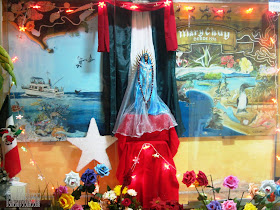 |
| Lady of Guadalupe Altar at Mary Chuy Fishing Charters |
46 Rosaries
If you are spending winter or visting Barra de Navidad during the months of October, November and early December you will probably have noticed in the evenings around 5:00 or 6:00 pm small groups of people gathering in businesses, restaurants, or houses in front of a small altar with an image of the Lady of Guadalupe.
 |
| Virgin of Guadalupe Altar at Sea Master Restaurant |
These people get together to pray the Rosary during 46 days starting October 28th. and finishing December 12th. The groups are organized by neighbors who live or have businesses closed by in the different sectors of Barra de Navidad and Barrio San Felipe de Jesús.
People in the group take turns to host a reunion that last about an hour, the host also sets the altar in their house or business where the group will pray the Rosary that day, and after finishing praying the Rosary the host invite their guests for a small appetizer like tacos dorados, rice pudding, or just a soft drink or agua de jamaica. After finishing the appetizer the group go in a small pilgrimage carrying the image of the Virgin of Guadalupe, flowers and ornaments for the altar and singing to the house of the host where the Rosary will be prayed the next day.
A small start will also be hanged to the dress of the image and a collection is made for members of the group to buy flowers, or contract a Mariachi band on December 12th. when the Lady of Guadalupe feast is celebrated.
 |
| Virgin of Guadalupe Altar at Casa Diaz grocery store corner of Veracruz and Jalisco streets |
The last day the group get together is on December 11th. when all the different groups take their images to the Barra de Navidad church.
 |
| Altar at Sea Master Restaurant - Lady of Guadalupe Feast in Barra de Navidad, Jalisco Mexico |
Lady Of Guadalupe Feast on December 11th
A rosary and pilgrimage to the main church with the Lady of Guadalupe images. A mass is celebrated usually at 9 pm and a serenade "mañanitas a la virgen" with live music (mariachis or a band ) for the Lady of Guadalupe is played after the mass.
 |
| Mañanitas a la Virgen - Lady of Guadalupe Feast in Barra de Navidad, Jalisco Mexico |
Lady of Guadalupe Feast on December 12th.
A pilgrimage and "Danzas" to the Barra de Navidad Church with the Lady of Guadalupe images and starts participating families of Barra de Navidad and from the San Felipe de Jesús barrio. This pilgrimage starts in the highway by the football field (corner with Nueva España Ave.) and ends in the Barra de Navidad church in downtown. A mass is celebrated after the pilgrimage.
.JPG) |
| Getting ready for the pilgrimage - Lady of Guadalupe Feast in Barra de Navidad, Jalisco Mexico |
.JPG) |
| Doña Petra - Getting ready for the pilgrimage - Lady of Guadalupe Feast in Barra de Navidad, Jalisco Mexico |
.JPG) |
| Getting ready for the pilgrimage - Lady of Guadalupe Feast in Barra de Navidad, Jalisco Mexico |
 |
| Mass after the pilgrimage - Lady of Guadalupe Feast in Barra de Navidad, Jalisco Mexico |
.JPG) |
| Virgenes con estrellas - Lady of Guadalupe Feast in Barra de Navidad, Jalisco Mexico |





.JPG)
.JPG)
.JPG)

.JPG)







